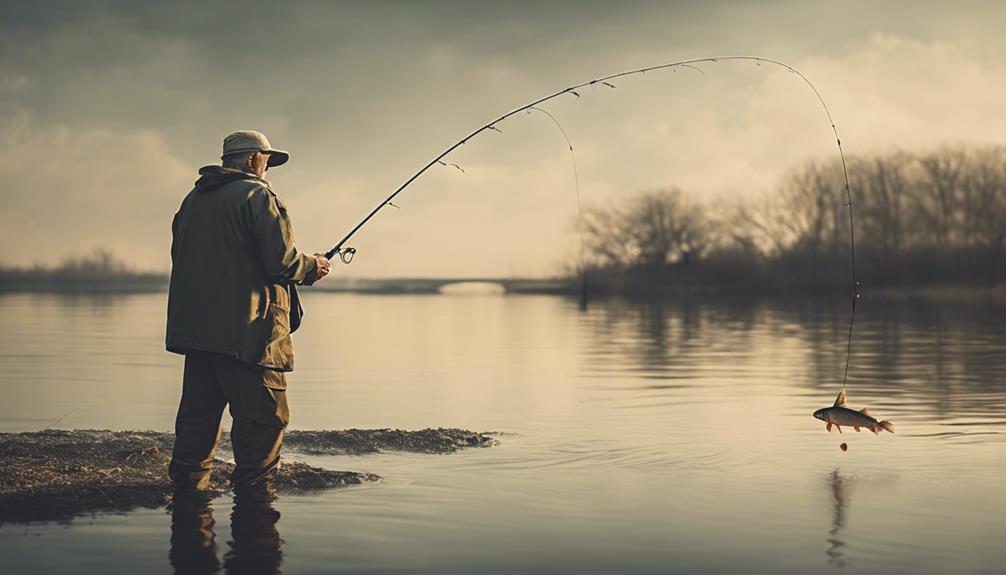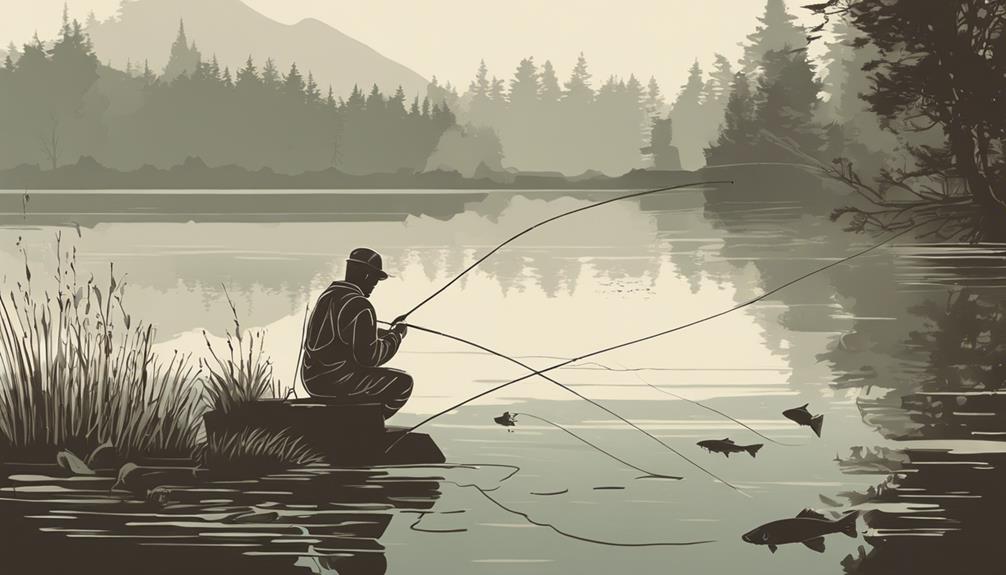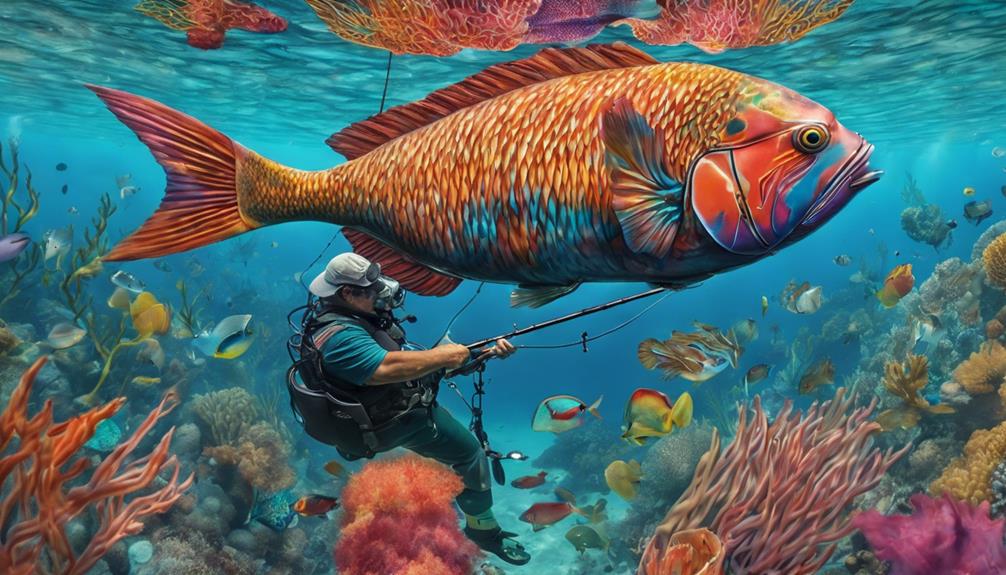When it comes to successful carp angling, mastering just one technique won't cut it. To truly excel in this art, you need to combine a set of proven strategies that will set you apart from the average angler.
Imagine the satisfaction of consistently reeling in prized carp with finesse and skill. Each technique plays a crucial role in your success, elevating your game from amateur to expert.
As you delve into the nuances of each method, you'll unlock the secrets that seasoned anglers swear by, paving your way to a whole new level of carp fishing proficiency.
Choosing the Right Carp Bait
When selecting your carp bait, consider the water conditions and the preferences of the carp in that specific location. Carp bait selection is crucial for a successful angling experience. Timing plays a significant role in determining the effectiveness of your bait. Carp are more active during certain times of the day, such as early morning or late evening. By aligning your bait presentation with these peak activity periods, you increase your chances of attracting carp.
Bait presentation is another key factor to consider. How you present your bait can make a significant difference in enticing carp to bite. Make sure your bait is appealing and mimics the natural food sources of carp in the area. Pay attention to the depth at which you place your bait. Carp often feed at different depths depending on the time of day and water temperature. Adjusting the depth of your bait accordingly can lead to more successful catches.
Experiment with different types of bait to see what works best in the specific location you're fishing. Some carp may prefer boilies, while others might be more attracted to corn or bread. By understanding the preferences of the carp in the area and adapting your bait selection and presentation accordingly, you can improve your chances of a successful angling trip.
Utilizing Effective Carp Rigs
Want to increase your chances of a successful carp angling experience? Start by mastering the art of utilizing effective carp rigs. When it comes to carp fishing, rig customization plays a crucial role in attracting these elusive fish. By adjusting your rig to suit the fishing conditions and the behavior of the carp in your chosen water body, you can greatly enhance your chances of a successful catch.
Bait presentation is key when it comes to carp fishing. Make sure your rig allows for your chosen bait to be presented in a natural and enticing manner. Carp can be quite picky at times, so ensuring that your bait looks appealing and moves naturally in the water can make a significant difference in getting a carp to take a bite.
Consider the hook size and line strength when setting up your rig. The hook size should match the bait you're using and the size of the carp you're targeting. Opting for a strong line is essential as carp are powerful fish that can easily break a weak line. Balancing the hook size and line strength will help you land more carp successfully.
Mastering Carp Feeding Behavior
To effectively master carp feeding behavior, understanding their dietary preferences and feeding patterns is essential for increasing your chances of a successful angling experience. Carp are omnivorous fish, feeding on a variety of natural food sources such as insects, crustaceans, plants, and small fish. Observing their feeding patterns can provide valuable insights into the best bait selection for a successful catch.
Carp exhibit certain behavioral cues that can help you tailor your fishing strategy. For example, when carp are actively feeding near the surface, using floating baits like bread crusts or dog biscuits can be effective. On the other hand, if carp are feeding at the bottom, presenting a bait that sinks slowly or using a method feeder can be more successful. Paying attention to the water's surface for signs of carp bubbles or movement can also guide your bait placement.
When selecting bait for carp, consider using natural baits like sweetcorn, boilies, or pellets, as these tend to appeal to their dietary preferences. Experimenting with different bait sizes, colors, and flavors can help you determine what works best in a particular fishing spot. By understanding carp feeding patterns and adjusting your bait selection and fishing strategy accordingly, you can enhance your chances of a rewarding angling experience.
Understanding Carp Habitat Preferences
Exploring the diverse habitat preferences of carp can significantly enhance your angling success by pinpointing key locations for optimal fishing opportunities. Understanding where carp thrive based on water temperature and underwater structure is crucial for a successful angling experience.
Carp are highly sensitive to water temperature, preferring areas where the temperature is stable and comfortable. During colder months, they tend to seek out deeper waters where temperatures are more consistent. In contrast, during warmer months, they may move to shallower areas where the water is warmer. By monitoring water temperatures in different parts of the water body, you can locate areas where carp are likely to be present.
Another important factor to consider is underwater structure. Carp are known to seek out areas with ample underwater structure, such as submerged logs, weed beds, or rocky areas. These structures provide carp with shelter, protection, and access to food sources. When scouting for carp habitats, look for features like these that can attract carp.
To maximize your chances of catching carp, target areas that align with their habitat preferences. By focusing on water temperature variations and underwater structures, you can increase your angling success and reel in more carp on your next fishing trip.
Perfecting Carp Hooking Techniques
Mastering the art of hooking carp requires precision and finesse to secure a successful catch. When it comes to hook setting, timing is crucial. As soon as you feel a carp nibbling on your bait, gently but swiftly set the hook by giving a firm yet controlled tug on your line. This action should embed the hook securely in the fish's mouth, increasing your chances of a solid hook-up.
Line control is equally important in perfecting your carp hooking technique. Keep your line taut but not overly tight, allowing the carp to move with the bait without feeling too much resistance. Maintaining the right amount of tension in your line enables you to feel even the slightest movements, indicating when a carp is showing interest in your bait.
Employing the Best Carp Rods
When selecting carp rods, prioritize flexibility and strength to enhance your angling experience. The right rod can significantly impact your success in catching carp. Rod selection should be based on factors like casting accuracy, line strength, and drag settings.
For carp angling, consider a rod with a test curve between 2.75lb to 3.25lb for general use. This range provides a good balance of flexibility and strength to handle the weight and power of carp. A longer rod, around 12 to 13 feet, allows for better casting accuracy, especially when targeting specific areas where carp are feeding.
When choosing a carp rod, pay attention to its action. A progressive action rod is a popular choice as it offers a good compromise between playing fish and casting ability. It provides the flexibility needed to handle sudden movements of carp while maintaining the strength required to control them.
Additionally, ensure that your rod complements the line strength you're using. The rod should have enough backbone to handle the pound test of your line without being too stiff, which could result in pulled hooks or snapped lines. Adjust the drag settings on your reel to match the rod's capabilities, allowing you to control the fish during the fight. By carefully selecting your carp rod, you set yourself up for a successful angling session.
Fine-Tuning Carp Reeling Tactics

To enhance your carp angling success, refine your reeling tactics for maximum efficiency in landing these powerful fish. When it comes to fine-tuning your carp reeling tactics, paying attention to crucial details can make a significant difference. Here are some key aspects to focus on:
- Rod Positioning: Proper rod positioning is essential when reeling in carp. Keep your rod at a moderate angle to maintain control over the fish while also allowing it to make runs without snapping your line. Adjust the angle based on the carp's movements to avoid putting excessive pressure on the line.
- Line Tension: Maintaining the right amount of tension on the line is vital during the reeling process. Too much tension can lead to line breakage, while too little can allow the carp to escape. Find the balance by keeping a steady but not overpowering tension as you reel in the fish.
- Drag Adjustment: Carp are known for their powerful runs, so having the drag set correctly is crucial. Make sure your drag is adjusted to accommodate sudden bursts of energy from the carp while preventing the line from breaking under pressure.
- Carp Behavior: Understanding carp behavior can give you an edge when fine-tuning your reeling tactics. Pay attention to how the fish responds to your movements and adjust your reeling speed and pressure accordingly to outsmart the carp and secure your catch.
Maximizing Carp Fishing Success
For optimal results in carp fishing, focus on maximizing your efficiency and strategic approach. Understanding carp behavior through analysis is key. Carp are known to be cautious and easily spooked, so observing their movements and feeding patterns can help you anticipate their behavior. By studying their habits in different weather conditions, you can fine-tune your angling strategies accordingly.
Weather impact plays a crucial role in your fishing success. Carp are sensitive to changes in weather, especially pressure and temperature. Before heading out, check the weather forecast to adapt your tactics. For example, on hot days, carp tend to stay in deeper, cooler waters, while they may be more active near the surface during overcast or rainy weather.
When it comes to maximizing your carp fishing success, patience is key. Set up your gear quietly and avoid making sudden movements that could scare the carp away. Use the right bait and adjust your rigs based on the conditions you observe. By staying attuned to carp behavior and adapting your angling strategies accordingly, you can significantly increase your chances of a successful catch. Remember, successful carp fishing requires a combination of skill, observation, and strategic thinking.
Frequently Asked Questions
Can Carp Fishing Be Successful in All Types of Weather Conditions?
In all types of weather conditions, carp fishing can be successful.
Winter fishing requires patience and using baits that appeal to carp in colder water.
Summer fishing is great for more active carp, using surface baits or zig rigs.
Rainy days can lead to more carp activity as they search for food, while sunny days may require fishing in shaded areas.
With the right techniques and gear, you can catch carp in any weather!
How Do You Properly Handle and Release a Caught Carp to Ensure Its Survival?
When handling and releasing a caught carp, proper techniques are crucial for its survival. Ensure you support the fish correctly, avoiding unnecessary stress.
Keep the fish in the water as much as possible, only lifting it briefly for a quick photo if desired.
Release gently, allowing the carp to swim away on its own terms. These methods help maintain the fish's well-being and increase its chances of thriving after being caught.
Is There a Specific Time of Day That Is Best for Carp Fishing?
For successful carp angling, the best time of day is usually early morning or late evening. Carp are more active during these times.
The optimal location would be near areas with vegetation or structures where carp tend to feed.
Using the best bait, like corn or boilies, can also increase your chances of a catch.
Remember to be patient and observant to make the most of your carp fishing experience.
What Are Some Common Mistakes That Beginner Carp Anglers Should Avoid?
When you're just starting out with carp angling, be mindful of common mistakes.
Pay attention to bait selection for the best chance of success.
Work on your casting accuracy to reach the right spots.
Make sure you have proper gear to handle these powerful fish.
Most importantly, practice patience; carp fishing requires waiting for the right moment.
Avoid rushing and enjoy the process of learning and improving your skills.
Are There Any Specific Regulations or Restrictions to Be Aware of When Carp Fishing in Different Locations?
When fishing for carp in different locations, it's crucial to understand the fishing regulations that apply.
Each area may have its own set of rules regarding carp fishing, including local restrictions.
For instance, international waters might've specific guidelines for anglers.
To ensure a successful and legal fishing experience, always research and abide by the fishing regulations in the area you plan to fish in.
Conclusion
Now that you have learned the 6 best techniques for successful carp angling, it's time to put your newfound knowledge to the test.
By choosing the right bait, utilizing effective rigs, mastering feeding behavior, understanding habitat preferences, perfecting hooking techniques, and employing the best rods, you can increase your chances of a successful catch.
Remember to fine-tune your reeling tactics and maximize your fishing success.
Get out there and reel in those carp!



